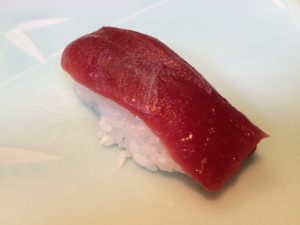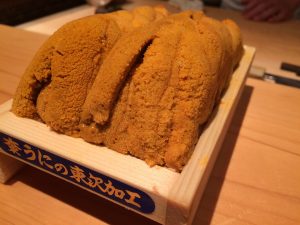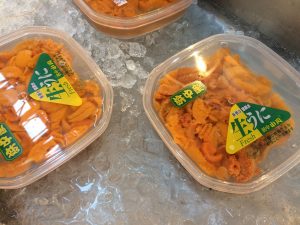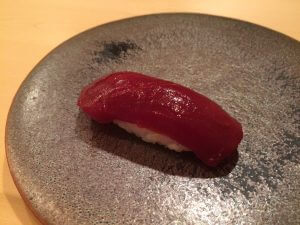 Zuke is one of the traditional Edo-style sushi methods. It is said that it was started in the Edo period to stop tuna from rotting when there were large amounts of the fish in the market. Now that there has been advances in refrigeration technology, it’s no longer necessary, but maturing the fish gives it a completely different taste and brings out its umami. Zuke is divided into two broad methods. Here we describe the characteristics of each.
Zuke is one of the traditional Edo-style sushi methods. It is said that it was started in the Edo period to stop tuna from rotting when there were large amounts of the fish in the market. Now that there has been advances in refrigeration technology, it’s no longer necessary, but maturing the fish gives it a completely different taste and brings out its umami. Zuke is divided into two broad methods. Here we describe the characteristics of each.
Recently, most sushi restaurants incorporate the “Single Zuke”.
Each slice of tuna is soaked separately, so it can mature quickly. The immersion time is only a few minutes. The idea is to marinate just enough so that the tuna’s aroma remains and the soy sauce doesn’t overtake it.
On the other hand, the old Edo-style method is to perform Zuke after parboiling.
Parboiling means to wrap the fish in a wet cloth, and poor boiling water on the wrapping until the color of the tuna changes color, then turn the fish over and repeat the process. The fish is then put in ice water so the heat doesn’t go too deep in the meat. It is immediately removed once it cools so that it doesn’t get too watery. The tuna is then put in Zuke soy sauce and left to marinate for about half a day. In this method, the soy sauce only soaks into the surface part where the color changed from the parboiling, so the flavor of the tuna remains.
Both methods keep the maximum tuna flavor possible. Tuna is an essential part of Edo-style sushi. There is great diversity between sushi restaurants in the parts, marinating time and flavor of Zuke, which creates a new, original flavor when the lean meat of the tuna soaks up the soy sauce. The fattiest cuts of tuna are most popular. The lean meat has only become more popular due to a rekindled interest in zuke, but in fact during the peak of the bubble economy, there was a time when high-end restaurants in Ginza didn’t know what to do with all their leftover lean tuna meat. It’s almost unbelievable to think of it now.
We hope this information will be helpful.

Revision date: August 1, 2017
Share this article
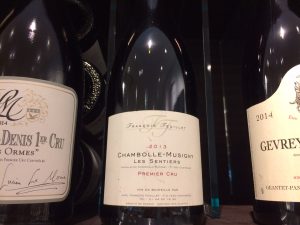 Fermented beverages such as sake and wine pair well with sushi. Sake is made from rice. So it only makes sense that this would pair well with sushi – also made with rice. It is also the only alcohol that eliminates the smell of fish and shellfish.
Fermented beverages such as sake and wine pair well with sushi. Sake is made from rice. So it only makes sense that this would pair well with sushi – also made with rice. It is also the only alcohol that eliminates the smell of fish and shellfish.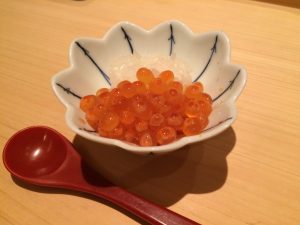 However, neither red nor white wine goes well with herring or salmon roe. The iron specific to wine is said to contribute to the fishy smell of fish roe.
However, neither red nor white wine goes well with herring or salmon roe. The iron specific to wine is said to contribute to the fishy smell of fish roe.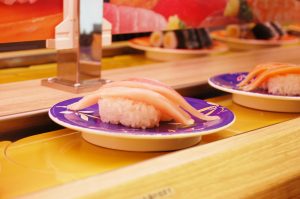 In some cases a two-piece sushi dish you can get for JPY 100 at Kaiten-zushi (Conver belt sushi) can cost up to 2,000 for half the volume at a fancy restaurant. Many Kaiten-zushi establishments are part of large chains so costs are kept low by buying in bulk.
In some cases a two-piece sushi dish you can get for JPY 100 at Kaiten-zushi (Conver belt sushi) can cost up to 2,000 for half the volume at a fancy restaurant. Many Kaiten-zushi establishments are part of large chains so costs are kept low by buying in bulk. While different from fancy sushi restaurants that serve various seasonal fish and edomaeshigoto, Kaiten-zushi has its own merits and offers sushi at a much lower price. It’s really up to the customer what they hope to get from their sushi experience.
While different from fancy sushi restaurants that serve various seasonal fish and edomaeshigoto, Kaiten-zushi has its own merits and offers sushi at a much lower price. It’s really up to the customer what they hope to get from their sushi experience.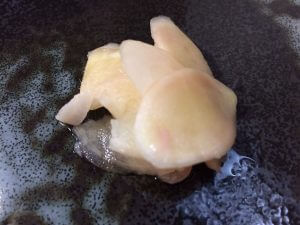 Gari is pickled ginger.
Gari is pickled ginger.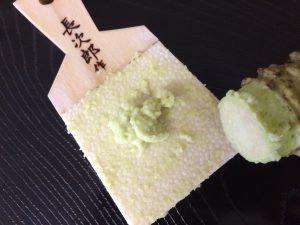 On the other hand, wasabi works by numbing senses of taste and smell with a stimulating spice so that the consumer doesn’t experience the fishy smell.
On the other hand, wasabi works by numbing senses of taste and smell with a stimulating spice so that the consumer doesn’t experience the fishy smell.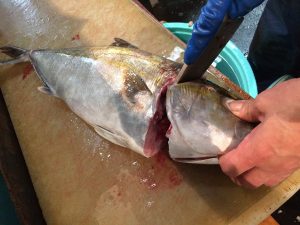 How the fish is butchered also changes the taste. If the fish suffers and struggles, the body wears and may be damaged, circulating oxidized blood throughout the body, which makes it lose flavor. For fish of high value such as sea bream, flounder, yellowtail, rudderfish and tuna, a method called “
How the fish is butchered also changes the taste. If the fish suffers and struggles, the body wears and may be damaged, circulating oxidized blood throughout the body, which makes it lose flavor. For fish of high value such as sea bream, flounder, yellowtail, rudderfish and tuna, a method called “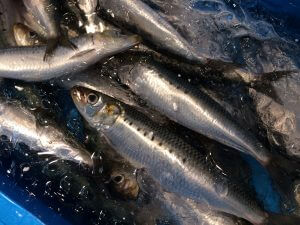 Freezing the fish to death in ice water is called “
Freezing the fish to death in ice water is called “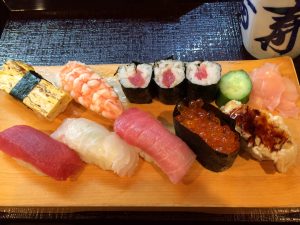 Even if you order beer or sake at sushi restaurants, your meal will always end with a cup of tea. But if you’re going to go out for sushi, you should really start drinking that tea earlier instead of saving it until the end. The tea at sushi shops is far more significant than a simple beverage. Especially when eating fatty tuna or bonito, tea plays a role that beer and sake simply cannot fulfill.
Even if you order beer or sake at sushi restaurants, your meal will always end with a cup of tea. But if you’re going to go out for sushi, you should really start drinking that tea earlier instead of saving it until the end. The tea at sushi shops is far more significant than a simple beverage. Especially when eating fatty tuna or bonito, tea plays a role that beer and sake simply cannot fulfill.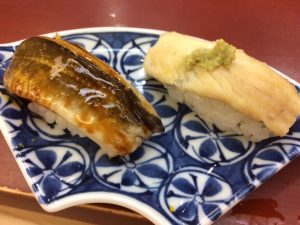 Sushi restaurants that advertise “Edo style” on the sign somewhat fear customers who order Anago (conger eel) right off the bat. If the customer then eats as if they are really taking the time to taste the sushi, then any chef not fully confident in their skills will want to hide under the sushi counter.
Sushi restaurants that advertise “Edo style” on the sign somewhat fear customers who order Anago (conger eel) right off the bat. If the customer then eats as if they are really taking the time to taste the sushi, then any chef not fully confident in their skills will want to hide under the sushi counter.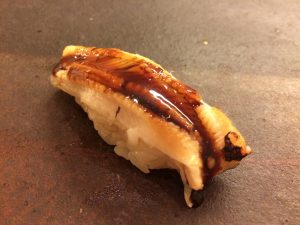
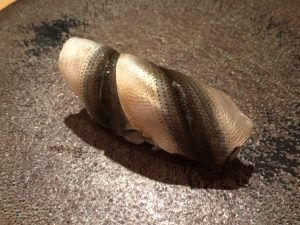 According to most sushi masters, salt is the defining factor in the taste of
According to most sushi masters, salt is the defining factor in the taste of 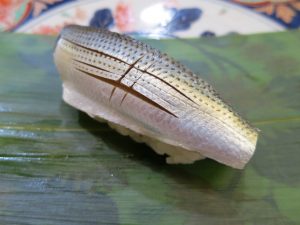 For example, a more slender fish in the middle of summer may be salted for 30 minutes, but a fatty fish in the winter needs to be salted for four hours. Just a few minutes longer or shorter than the perfect salting time completely changes the taste of the final dish.
For example, a more slender fish in the middle of summer may be salted for 30 minutes, but a fatty fish in the winter needs to be salted for four hours. Just a few minutes longer or shorter than the perfect salting time completely changes the taste of the final dish.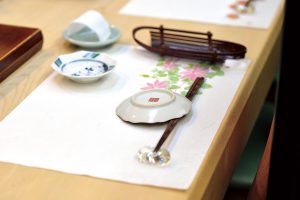 The sushi restaurant is unusual in that the customer sitting at the counter can see the seafood (neta) from which individual servings will be made, and can watch the chef deftly perform his art while enjoying lively conversation. Sushi restaurants also differ from other restaurants when it comes to menus.
The sushi restaurant is unusual in that the customer sitting at the counter can see the seafood (neta) from which individual servings will be made, and can watch the chef deftly perform his art while enjoying lively conversation. Sushi restaurants also differ from other restaurants when it comes to menus.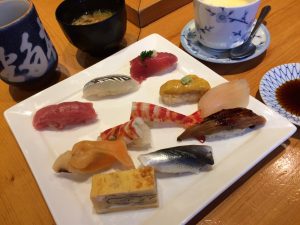 If the customer is inclined to worry about what the bill will come to, he orders
If the customer is inclined to worry about what the bill will come to, he orders 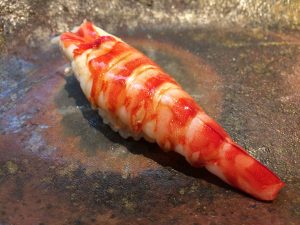 People at the counter most often order
People at the counter most often order 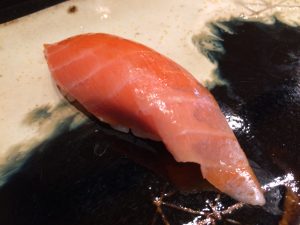 The Japanese were not in the habit of eating salmon raw. Salmon was not a traditional topping in Edo-style sushi. The reason for this is that the existence of parasites has been well-known since long ago and there was no way to prepare the salmon raw.
The Japanese were not in the habit of eating salmon raw. Salmon was not a traditional topping in Edo-style sushi. The reason for this is that the existence of parasites has been well-known since long ago and there was no way to prepare the salmon raw.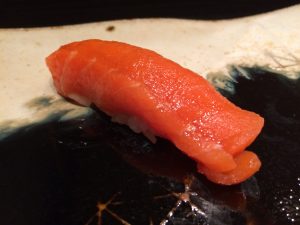
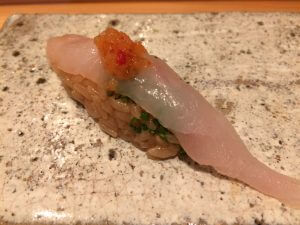 Instead of looking at the topping, take a moment to focus on the vinegared rice (
Instead of looking at the topping, take a moment to focus on the vinegared rice (